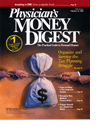Publication
Article
Physician's Money Digest
Recognize New Medical Practice Risks
In the past, the term "risk management" referred tomethods of medical malpractice claims avoidance.Insurance companies provided risk managementseminars to instruct physicians on methods of defensivemedicine to limit their malpractice risks.
However, the emphasis on malpractice under today'slegal and political environment may be misplaced. A medicalmalpractice action is mainly about money—the insurancecompany's money. However, the risks involved inactual medical practice today may be much greater thanthe risks involved in a medical malpractice action. Theserisks are also mostly about money—your money.
Want evidence? Charles F. Fenton III, MD, JD, speakingat a medical risk management seminar, commented,"The greatest challenge facing physicians today is to preserveand improve the quality of medical care in the face ofdiminishing resources. A major part of this challenge is theprevention of financial losses from litigation other than amalpractice action. These losses may be in the form ofdirect costs (eg, legal fees, unnecessary insurance, and thewrong type of insurance coverage) or indirect costs (ie, notrecognizing new medical practice risks and perils).Whether direct or indirect, such losses reduce the resourcesavailable for necessary patient services. Such is the task ofvirtually all risk management efforts in medical practice."
To keep physicians in the know, the following are threenew medical practice risks:
Expert Witnesses
In the past, a physician expert witness for the plaintiffwas an opposing opinion by a colleague. Today, this practiceis becoming a risk management minefield as the AMAand other groups are urging state medical licensing boardsto police expert witnesses. This seems especially true withthe Rolling Meadows, Ill-based American Association ofNeurological Surgeons (AANS; www.aans.org).
Currently, a member of the AANS can file a complaintagainst any fellow member for testimony as either anexpert witness for the plaintiff or a defense witness for thedoctor. A committee of four then reviews the court recordsand requires the accuser to face the accused in a formalreview. Sanctions range form 3 months to 1 year, to completeexpulsion from the association. In the past 20 years,the program has reviewed 27 cases, all involving plaintifftestimony. One led to expulsion and ten to suspension.
Remember:
Since 2001, the courts are taking the AANS processseriously. After years of operating without strong legalbacking, the program was upheld by the Seventh CircuitCourt of Appeals in Chicago by a neurosurgeon whom thegroup suspended in 1997. If you testify falselyor far from the norm, you may also be at risk.
Peer Review Process
The Center for Peer Review Justice (CPRJ; www.peerreview.org) is a group of physicians, dentists, podiatrists,and osteopaths who have witnessed the perversion of medicalpeer review by malice and bad faith. Like the AANS,they have seen the statutory immunity, which is providedto peers for the purposes of quality assurance and credentialing,used as a cover to allow those peers to ruin careersand reputations to further their own, usually involving amonetary agenda of destroying the competition.
The group is dedicated to the exposure, conviction,and sanction of doctors as well as affiliated hospitals,HMOs, medical boards, and other such institutions thatwould use peer review as a weapon to unfairly destroyother professionals. The CPRJ is a rallying point andresource center for any medical professional who finds thatthey are in the midst of an unfair and bad faith attack byunethical, malicious peers.
On-call Refusal
It's getting more expensive these days to take hospitalcalls. Physicians are electing not to take this responsibilitybecause of decreased reimbursement rates. Others opt outbecause of scheduling conflicts or a desire to spend moretime with family. Regardless, there is a growing revolt ofspecialists against hospital on-call duties that threatens toviolate federal law and lose status as trauma centers.Specialists most likely to refuse include plastic surgeons;ear, nose, and throat specialists; psychiatrists; neurosurgeons;ophthalmologists; and orthopedists. Refusing torespond to an assigned call is a violation of federal law andcarries fines of as much as $50,000 per case.
In contrast, refusing to sign up for on-call status doesnot violate the law, and more physicians are taking thisoption. The problem is especially acute in California,where hospitals are combating the issue by increasing on-callcompensation and reporting those who refuse calls tothe authorities or threatening to remove them from staff.In turn, doctors are fighting back with lawsuits.
Successful risk management is often very simply a matterof hazard recognition. A good rule of thumb is to recognizechange and remain open to ideas that identify andprovide solutions to the ever-evolving risk managementproblems of contemporary medical practice.
is a licensed insurance agent
and distinguished visiting instructor of health care
administration at the University of Phoenix,
Graduate School of Business and Management.
He is the academic provost for www.Medical
BusinessAdvisors.com, sponsor of the prestigious
Certified Medical Planner© charter designation
program. His two newest books are Insurance and Risk Management
Strategies for Physicians and Advisors and Financial Planning
Handbook for Physicians and Advisors (Jones and Bartlett Publishers;
2005). He welcomes questions or comments at 770-448-0769
or marcinkoadvisors@msn.com.
David E. Marcinko
